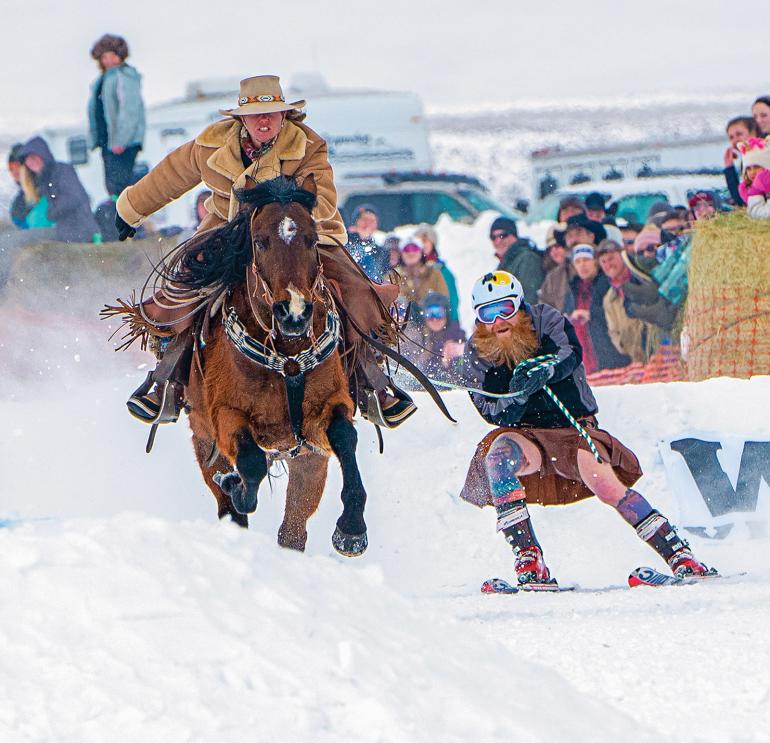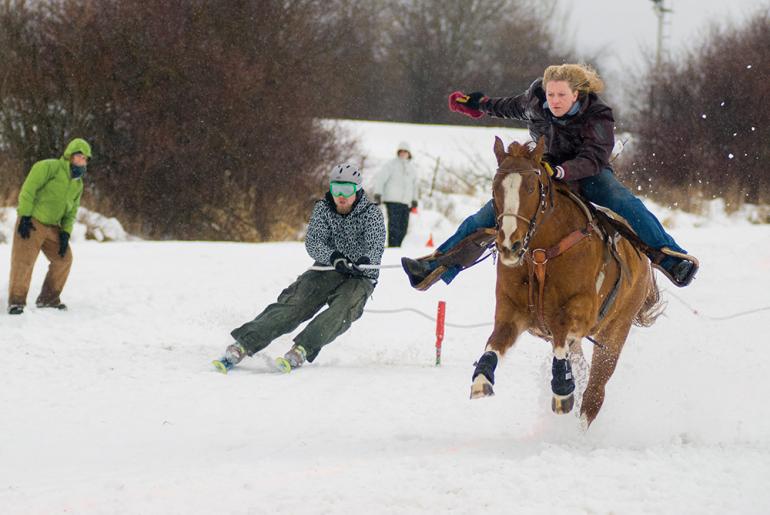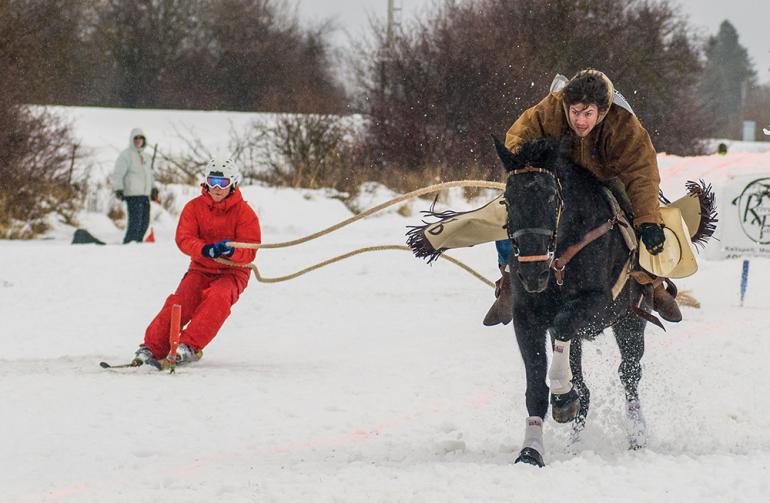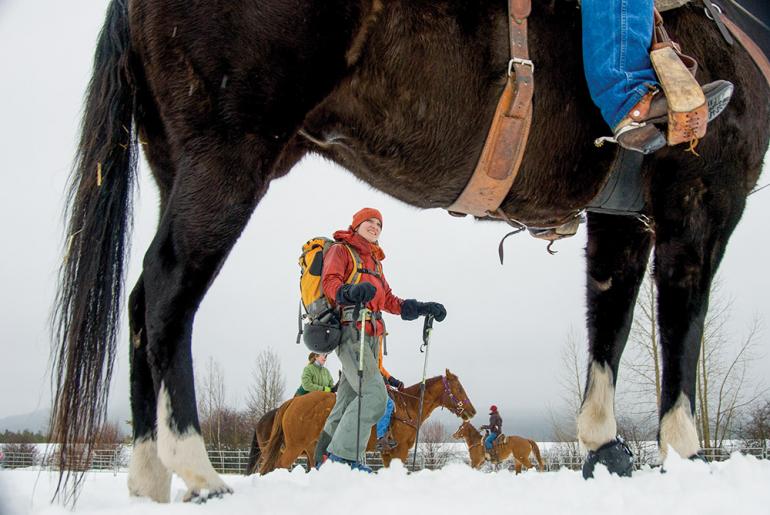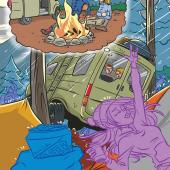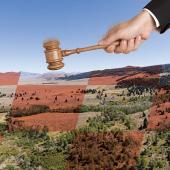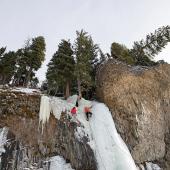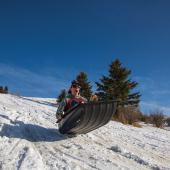Blazing Saddles
Skijoring: from origin to current-day.
Tucked away on the back wall of a rustic bar & grill in the Big Hole Valley hangs an 80-year-old photograph of a young girl named Joyce Hershy McDowell and her two cousins. They are wide-eyed and giddy, their wool britches dusted in snow, as the trio is towed over a family hayfield on skis by their trusty horse, Banjo. The town is called Wisdom, the bar & grill, the Crossing at Fetty’s, and the sport, Skijoring. Welcome to southwest Montana.
For two decades, Wisdom has held a skijoring event on the last weekend of February. Initially, the race thundered right through town. These days, a layer of fresh snow is tilled and compacted to a safe depth for the horses on an old airstrip along the highway. Gates are set, jumps built, and ring stands erected for skiers. Onlookers are sprayed with flying snow as horses kick up their hooves and skiers carve sharp turns. Spectators cheer and duck under pitched tents to indulge in whiskey, beer, and brats. Bonfires line the course, and children play in snowpiles as most would in sandboxes. Just another day at the beach in Montana.
Skijoring gives Wisdomites a shot at friendly competition, a remedy for cabin fever, and a chance to raise money for causes like helping neighbors in need and funding an annual veteran’s equine-therapy program. For a town of under 100, this is quite an undertaking, but like the sport, the town has plenty of gumption and purpose. The after party at the Crossing is a boot-stompin’, hootin’-and-hollerin’ celebration.
Skijoring is also a “crossing.” Of humans and horses, of cowboys and skiers, of speed and patience, and of Europe and America. The sport started in Scandinavia, hence the term, “skijøring” or “being driven forward on skis,” but originally skiers were towed by reindeer.
The equine version appeared in alpine Europe in the early 1900s, then migrated to Lake Placid, New York as a recreational activity around 1914. From there, it spread westward in the 1930s, popularized during the first Winter Olympic Games in 1928 in Saint Moritz, Switzerland. Skijoring is now showcased throughout the Rocky Mountain West, and Montana in particular.
|
|
Red Lodge, 300 miles east of Wisdom, also has a rich skijoring tradition and was a natural place for an annual skijoring race to establish itself more than 30 years ago. The fairgrounds, adjacent to town and in the shadow of the ski mountain, provide a great venue for a seamless fusion of Red Lodge’s two local cultures, rodeo and skiing. On the second weekend of March, tailgaters form a continuous semi-circle around the course. By the end of the afternoon, everyone is ankle-deep in mud, but camaraderie and spirits are high. And the competition is fierce because this is, traditionally, the final event of the season.
Skijoring gives Wisdomites a shot at friendly competition, a remedy for cabin fever, and a chance to raise money for causes like helping neighbors in need and funding an annual veteran's equine-therapy program.
Larger cities like Helena and Bozeman, resorts like Big Sky, and smaller towns like Butte have thrown their hats in the ring in recent years as the popularity of skijoring surged, attracting hundreds of competitors and thousands of spectators. Prize pots reached into the tens of thousands and Calcuttas handsomely rewarded those betting on the teams with the most git-up-’n’-go.
But let’s get back to Joyce Hershy McDowell’s style of skijoring. Only in southwest Montana did the sport experience a revival as a recreational activity, a century after Lake Placid. In the Bitterroot Valley near the picturesque town of Darby, Triple Creek Ranch has towed willing cozy-cabin-dwellers through fresh powder on borrowed skis simply for fun. This activity has since been replaced by dogsledding, but guests are still treated to a day at the races when the nearby Wisdom skijoring event is in town.
Twenty years ago, the 320 Ranch, a stunning, historic property along the Gallatin River on the road to Yellowstone, began inviting local cowboys and skiers to compete purely as a means of entertainment for guests. The event has since moved up to the ski resort.
As time moves on, skijoring is here to stay, with over 20 races planned for 2022. Perhaps it may even make an appearance at the Winter Olympics again should the games go to Salt Lake City in 2030. If so, Montanans will likely be there armed with their spurs and skis, eager to take part.
For an updated list of events, go to skijorusa.com, and for an overall history, check out skijor.com.

